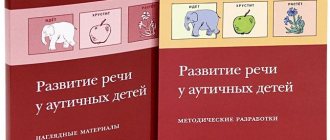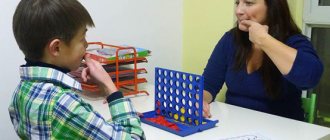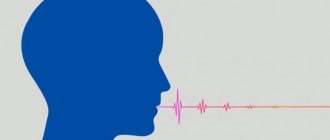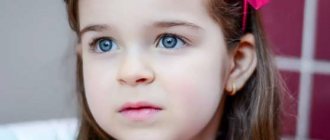Theoretical foundations of speech therapy. Principles and methods of speech therapy
Speech therapy is based on the following basic principles: systematicity, complexity, development principle, consideration of speech disorders in connection with other aspects of the child’s mental development, activity approach, ontogenetic principle, principle of taking into account etiology and mechanisms (etiopathogenetic principle), principle of taking into account the symptoms of the disorder and the structure of the speech defect , the principle of a workaround, general didactic and other principles.
Let's look at some of them. The principle of systematicity is based on the idea of speech as a complex functional system, the structural components of which are in close interaction. In this regard, the study of speech, the process of its development and correction of disorders involves influencing all components, all aspects of the speech functional system.
For a speech therapy conclusion, for the differential diagnosis of similar forms of speech disorders , a correlation analysis of speech and non-speech symptoms, data from a medical, psychological, speech therapy examination, correlation of the levels of development of cognitive activity and speech, the state of speech and the characteristics of the sensorimotor development of the child are necessary.
Speech disorders in many cases are included in the syndrome of nervous and neuropsychiatric diseases (for example, dysarthria, alalia, stuttering, etc.). Elimination of speech disorders in these cases should be comprehensive, medical, psychological and pedagogical in nature. , the principle of complexity is important . In the process of studying speech disorders and their correction, it is important to take into account the general and specific patterns of development of abnormal children.
The principle of development involves identifying in the process of speech therapy work those tasks, difficulties, and stages that are in the zone of proximal development of the child. The study of children with speech disorders, as well as the organization of speech therapy work with them, is carried out taking into account the child’s leading activities (subject-practical, playful, educational).
The development of a methodology for correctional speech therapy is carried out taking into account the sequence of appearance of the forms and functions of speech, as well as the types of activities of the child in ontogenesis ( ontogenetic principle ).
The occurrence of speech disorders in many cases is due to a complex interaction of biological and social factors. For successful speech therapy correction of speech disorders, it is of great importance to establish in each individual case the etiology, mechanisms, symptoms of the disorder, identification of leading disorders, and the relationship between speech and non-speech symptoms in the structure of the defect.
In the process of compensating for impaired speech and non-speech functions and restructuring the activity of functional systems, the principle of a workaround is used, i.e., the formation of a new functional system bypassing the affected link. An important place in the study and correction of speech disorders is occupied by didactic principles : clarity, accessibility, awareness, individual approach, etc.
The methods of speech therapy as a science can be divided into several groups. The first group is organizational methods: comparative, longitudinal (study over time), complex.
The second group consists of empirical methods: observational (observation), experimental (laboratory, natural, formative or psychological-pedagogical experiment), psychodiagnostic (tests, standardized and projective, questionnaires, conversations, interviews), praximetric examples of activity analysis, including speech activities, biographical (collection and analysis of anamnestic data).
The third group includes quantitative (mathematical-statistical) and qualitative analysis of the data obtained; machine data processing using a computer is used.
The fourth group is interpretive methods, methods of theoretical study of connections between the phenomena being studied (the connection between parts and the whole, between individual parameters and the phenomenon as a whole, between functions and personality, etc.).
Technical means are widely used to ensure the objectivity of the study: intonographs, spectographs, nasometers, video speech, phonographs, spirometers and other equipment, as well as X-ray cine photography, glottography, cinematography, electromyography, which make it possible to study the dynamics of integral speech activity and its individual components.
Periodization according to A. N. Leontiev
A. N. Leontyev identified 4 main stages of speech development in ontogenesis, which begin at birth and cover the school years. A brief description of them is presented below.
Preparatory stage
In the period from birth to one year, the prerequisites are created for mastering the components of the language system. The first vocal reactions are screaming and crying, which contribute to the development of the respiratory, vocal and articulatory departments.
At the age of several weeks, the baby begins to listen to the voices of the people around him and respond to them. By the end of the 1st month, he already calms down when he hears a lullaby. In the first months, a revival complex appears: a smile, motor movements of the limbs in response to the appearance of relatives. A reaction to the intonation of an adult appears.
At 2 months, humming appears, and by 3-4 months the babbling stage begins. From 5 months, the child tries to repeat the articulation of adults. From 6 months, syllables appear in speech. By imitating, the baby masters all the basic elements of the prosodic side of speech.
In the period from 6 months to one year, the child distinguishes certain sound combinations and compares them with objects or actions. Gradually, the baby repeats increasingly complex combinations of sounds after those around him. The end of the period is marked by the appearance of the first words and the activation of the communicative function of speech. At this time, it is very important for parents to create favorable conditions for the child to master the language system.
Developmental stage up to three years
Between one and three years of age, children pay special attention to the articulation of those around them. The child repeats after adults and tries to pronounce increasingly complex words. In his speech, phoneme mixtures, substitutions, and distortions occur due to the correct articulatory patterns that have not been formed due to age.
From one to 1.5 years, children's speech is situational (contextual) in nature. Understanding what a child wants can only be done by taking into account the situation. The baby actively uses non-verbal means of communication. Starting from 1.5 years, speech acquires a more generalizing orientation. He begins to understand adults' instructions. From 2 to 3, there is an active accumulation of vocabulary.
By the beginning of the 3rd year of life, simple grammatical categories are mastered. There is a transition from monosyllabic statements to simple phrases with violated agreement norms. Gradually, the child masters the skill of grammatically connecting words in a sentence. By the age of two, he has almost completely mastered the categories of singular and plural; case endings appear. Speech understanding is ahead of the child's pronunciation capabilities.
Preschool development period
In many children, sound pronunciation is distorted because the articulation organs are not yet ready for complex structures. Improves the skill of self-control over your speech and those around you; phonetic-phonemic processes are formed.
Vocabulary continues to grow, with children using approximately 3,000–4,000 words by ages 4–6. The meaning of words is clarified, but sometimes they are used in a way that does not correspond to their meaning. At the age of 4-5 years, the phenomenon of word creation occurs, during which the formation of a linguistic sense occurs.
Grammatical structure and coherent speech develop. Proposals become more complex and more widespread. At 4 years old, complex sentence structures predominate in children's speech. At the age of 5 years, sentences are composed taking into account the grammatical connections of words. Children's answers are like a short story. Mastery of the monologue form of speech begins; the preschooler can retell short fairy tales without the help of adults.
By the end of the preschool period, correct sound pronunciation, phonetic-phonemic processes and contextual speech are fully formed.
School period
Its duration is from 7 to 17 years. A distinctive feature is the conscious acquisition of speech. The skill of sound analysis and the grammatical rules of the native language are mastered. The main role is given to written speech. The child learns to consciously use acquired speech skills.
Patterns of normal speech development according to A. N. Gvozdev
The proposed scheme is based on the peculiarities of the appearance of parts of speech and grammatical categories in children. A. N. Gvozdev distinguishes two stages:
- use of amorphous words;
- mastery of grammatical categories.
When constructing correctional work, speech therapists rely on these patterns of ontogenetic speech development.
Amorphous root words
A. N. Gvozdev begins to consider the acquisition of the native language system from one year and 8 months, when the baby already has his first words. This stage is divided into two sub-periods, each of which has its own characteristics.
- One-word - the baby uses only individual words that act as sentences. Some of them serve to express his desires and feelings. At this time, he actively uses facial expressions and gestures. The first words do not have a clear grammatical form: he uses them in one sound image in different contexts (“bi” - car, driving, etc.).
Most of them are nouns, onomatopoeic complexes and babble. In total, the child’s dictionary during this period contains about 29 such amorphous words. He clearly pronounces vowels, labiolabials, front-lingual, back-lingual, Сь, Ль. The syllabic structure consists of one stressed syllable or two identical ones.
- The second sub-period is characterized by combining words into one phrase, but it is ungrammatical. Indeclinable nouns and verbs appear in the form of the imperative mood (“drink”, “give”, etc.). The syllable structure becomes more complex: the baby learns the pronunciation of two-syllable words. Хь, Ц, И appears, sometimes he may omit a sound at the beginning or end of a word. The baby also masters the pronunciation of consonant clusters that appear in the middle of some words.
During this age period, the prerequisites for the child’s successful mastery of the components of the language system are formed. He begins to use the simplest forms of parts of speech and sounds with simple articulation patterns.
Mastering the grammatical structure of sentences
This long period begins at 1 year 8 months. and lasts up to 6 years. The child masters all grammatical skills; The syllable structure and sound pronunciation are fully formed by the age of 5-6 years. Children are actively engaged in word creation. This phenomenon is caused by attempts to master the norms of the native language without knowing the grammatical rules.
First period
First forms of words (1 year 8 months – 2 years). The baby combines 3-4 words into a sentence. He masters the skill of agreeing a noun in the nominative case with a verb, and the initial signs of adjective subordination appear. Phrase speech itself is characterized by ungrammaticality.
Begins to decline words according to cases (nominative, accusative, prepositional); adds diminutive suffixes; new inflections of verbs appear; often omits prefixes.
During this period, the first adjectives appear, but the child uses them without agreement with the noun. Adverbs and pronouns appear (he speaks about himself in the 3rd person); particles. In three-syllable words the child omits the pre-stressed syllable, but in four-syllable words the syllable structure is most often preserved.
Articulatory structures N, T, D appear. Most of the consonant clusters are replaced by a single phoneme.
Second period
From 2 years to 2 years 6 months. endings are learned and conjunctions are added to sentences. A common mistake is replacing endings and using them within the same meaning. Suffixes, dative and instrumental cases appear. Begins to inflect verbs according to persons and tenses, but can mix gender.
The number of adjectives increases, but when using them, the child violates the norms of agreement. The plural form is used only in the nominative case. Personal pronouns are being learned; adverbs that are used for comparison. More prepositions and complex conjunctions appear.
In complex words, omission of pre-stressed syllables and prefixes is most common. The child often mixes similar phonemes in speech. The sequence of consonants remains unlearned, but he pronounces some groups correctly.
Third period
From 2.6 months By the age of 3 years, the child masters the functional parts of speech. The structure of the sentence becomes more complex, and the skill of subordinating words appears. But the child has not yet mastered the category of gender. Almost all the main case endings have been mastered, but the influence of O is more common in them. Suffixes denoting increase are being mastered.
The child freely uses all forms of reflexive verbs and prefixes. But sometimes he can mix them up. Begins to use coordination skills when constructing sentences. Forms of short participles appear. The child confuses possessive pronouns. Uses prepositions and most conjunctions correctly.
Distortion of syllable structure is rare, most often in unfamiliar words. Articulatory patterns of hissing sounds are formed; the pronunciation of consonant sequences is learned.
The fourth period
At 3-4 years old, agrammatic sentences become less and less common in children’s speech. The child is actively engaged in word creation. The ending -OV continues to influence the declination. Difficulties arise in agreeing neuter adjectives. The comparative degree of adjectives and adverbs, the particle BY, appears. The pronunciation side is fully formed.
Fifth period
The period from 4 to 6 years is characterized by the acquisition of almost all grammatical forms of parts of speech. The child has difficulty making sentences with the word “which”.
The boundaries of all the listed stages are approximate; everything depends on the individual characteristics of the child, on the conditions of the speech environment in which he grows. Thanks to knowledge of the stages of ontogenetic development of speech, it is possible to determine how the process of assimilation of language components proceeds. Taking into account ontogenetic and mental characteristics, speech therapists carry out correctional work.






